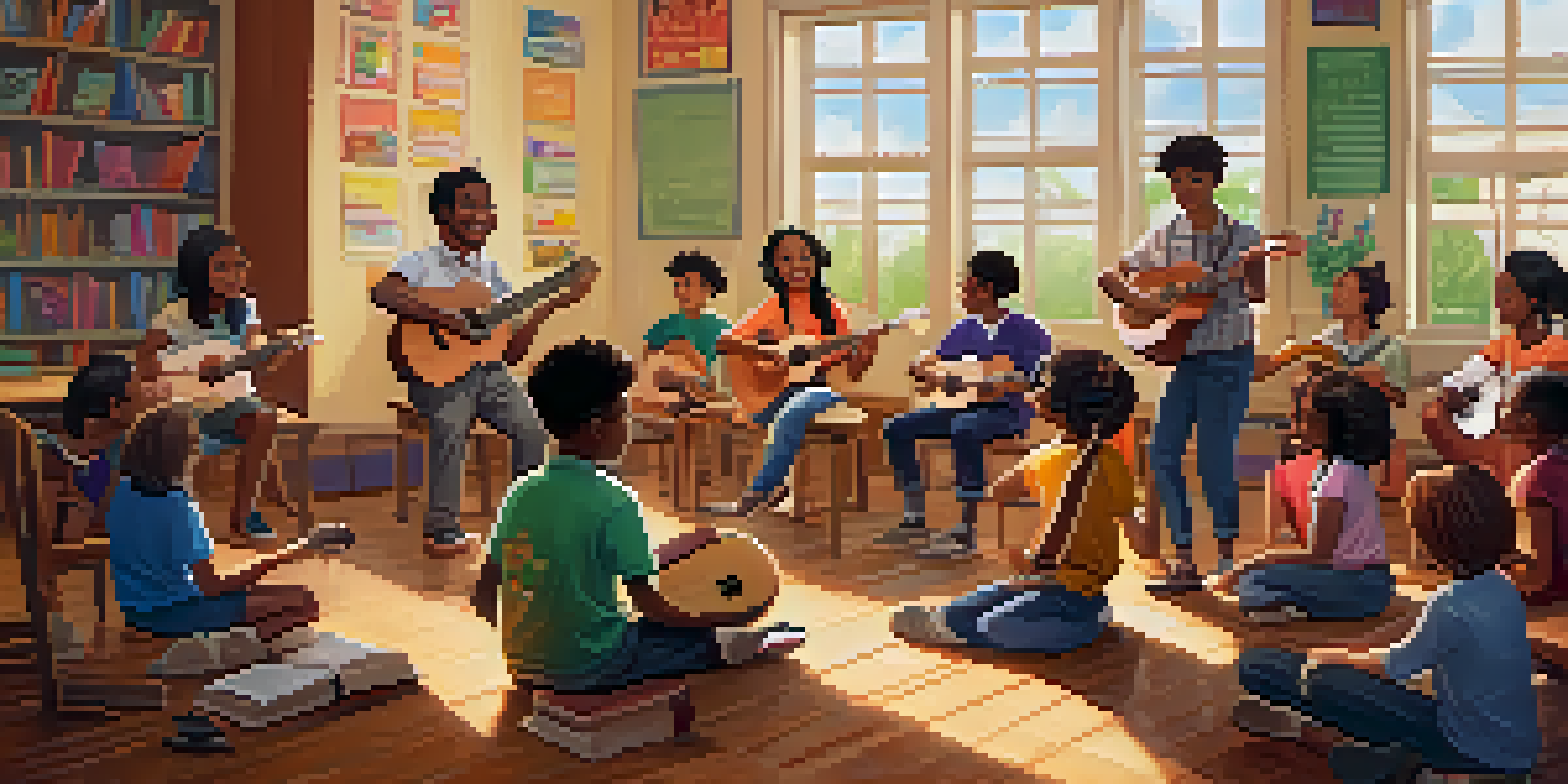Integrating Ukulele into Language Classes for Better Engagement

The Ukulele: A Gateway to Creativity in Language Learning
The ukulele is not just a charming instrument; it’s a powerful tool for fostering creativity in language classes. Its simple chords and light weight make it accessible for beginners, allowing students to explore music while learning a new language. By incorporating the ukulele, teachers can create a fun, interactive environment that encourages students to express themselves. This creative outlet can significantly enhance their confidence and willingness to participate.
Music is the universal language of mankind.
Imagine a classroom where students are not just reading from textbooks but strumming along to songs in their target language. This dynamic approach can transform the often daunting task of language acquisition into an enjoyable experience. As students learn to play and sing, they simultaneously practice pronunciation, vocabulary, and grammar. The ukulele becomes a bridge, connecting language learning with musical expression.
Moreover, using the ukulele helps to cater to various learning styles. Visual learners can follow chord charts, auditory learners can enjoy melodies, and kinesthetic learners can engage through the physical act of playing. This holistic approach ensures that all students are included, fostering a sense of belonging in the classroom.
Building Vocabulary Through Song Lyrics and Ukulele Chords
One of the most effective ways to expand vocabulary is through song lyrics. Teaching students to play the ukulele while singing songs in their target language allows them to learn new words in context. This method not only makes vocabulary memorable but also provides a cultural insight into the language being studied. Songs often encapsulate idioms and phrases that textbooks may overlook, enriching the learning experience.

As students strum along, they engage with the lyrics, which reinforces their understanding and retention of new vocabulary. This interactive learning encourages them to consider the meaning behind the words, promoting deeper comprehension. Additionally, students can be encouraged to write their own lyrics, which further solidifies their grasp of the language.
Ukulele Boosts Language Creativity
Incorporating the ukulele in language classes fosters a creative environment that enhances student engagement and confidence.
This blend of music and language creates a powerful synergy, where the rhythm of the ukulele helps with memorization. Students often find that they can recall vocabulary more easily when it's tied to a catchy tune. This method not only reinforces learning but also fosters a love for the language, making them more likely to pursue further studies.
Enhancing Listening Skills with Ukulele Accompaniment
Listening skills are crucial in language learning, and the ukulele can enhance this aspect significantly. By playing along to songs, students develop their ability to discern tone, rhythm, and pronunciation. The gentle sound of the ukulele provides a soothing backdrop, making it easier for students to focus on the lyrics and their meanings. This auditory experience can be more engaging than traditional listening exercises.
The beautiful thing about learning is that no one can take it away from you.
Moreover, students can participate in call-and-response exercises, where they listen to a line and then echo it back on their ukuleles. This approach not only improves their listening skills but also builds confidence in their speaking abilities. The collaborative nature of these activities promotes a supportive classroom environment where students feel comfortable making mistakes and learning from them.
Additionally, playing along with recordings can expose students to different accents and styles of speaking. This variety helps them become more adaptable listeners, preparing them for real-life conversations. The ukulele thus serves as a fun and effective tool for honing these essential skills.
Fostering Collaboration in Language Learning with Ukulele Groups
The ukulele is inherently social, making it a great instrument for collaborative learning. When students form small ukulele groups, they engage in teamwork, communication, and problem-solving as they learn together. This collaborative spirit can break down barriers, encouraging students to support one another in their language learning journey. The bonds formed in these groups can lead to lasting friendships and a more cohesive classroom atmosphere.
In group settings, students can share responsibilities, such as choosing songs or leading practice sessions. This shared ownership fosters a sense of accountability and investment in their learning. Additionally, as they teach one another, they reinforce their own understanding of the material, creating a positive feedback loop.
Songs Enhance Vocabulary Retention
Learning vocabulary through song lyrics and ukulele chords provides context and cultural insights, making new words more memorable.
Collaboration doesn't just happen in the classroom; students can also perform together at school events or community gatherings. These opportunities allow them to showcase their language skills and musical talents simultaneously, boosting their confidence and motivation. The ukulele acts as a catalyst for building community and collaboration in the learning process.
Cultural Exploration Through Ukulele Music and Language
Music is a powerful reflection of culture, and the ukulele can serve as a conduit for exploring the cultures associated with various languages. By studying songs from different regions, students gain insights into traditions, values, and histories that are integral to their language learning. This cultural exploration enriches their understanding and appreciation of the language beyond just vocabulary and grammar.
For instance, Hawaiian music, often played on the ukulele, can introduce students to the unique phrases and expressions of the Hawaiian language. Learning about the cultural context of the music fosters a deeper connection to the language and its speakers. This not only makes the learning experience more meaningful but also encourages respect and curiosity about other cultures.
Additionally, students can be encouraged to research and present on the cultural significance of the songs they learn. This integration of cultural studies into language classes creates a well-rounded curriculum that promotes global awareness. The ukulele, therefore, becomes a tool for not just language acquisition but also cultural appreciation.
Using Ukulele to Develop Confidence in Language Skills
The journey of language learning can sometimes feel overwhelming, but the ukulele can help mitigate that stress. By allowing students to express themselves musically, they can find joy in the learning process. This joy can lead to increased motivation, making them more eager to practice both their language and music skills. As they become more comfortable with the ukulele, their confidence in their language abilities often grows as well.
Performing in front of peers, whether it’s a small group or the entire class, provides an opportunity for students to showcase their skills. This experience can be nerve-wracking at first, but it ultimately builds resilience and self-assurance. As they receive positive feedback from their classmates, they realize that making mistakes is part of the learning process, and this can be a transformative moment.
Collaboration Through Group Play
Playing ukulele in groups promotes teamwork and strengthens bonds among students, enriching their language learning experience.
Moreover, the act of playing the ukulele can serve as a grounding technique, helping students manage anxiety related to speaking in their target language. The rhythmic nature of playing can be calming, allowing them to focus on their words rather than their fears. In this way, the ukulele doesn’t just enhance language skills—it also nurtures emotional well-being.
Practical Tips for Integrating Ukulele into Language Classes
Integrating the ukulele into language classes doesn’t have to be daunting. Start with simple songs that use just a few chords, making it easier for students to get the hang of playing while singing. Websites and apps offer a plethora of resources, including chord charts and video tutorials, ensuring that both teachers and students can feel confident in their abilities. A gradual introduction can help everyone ease into this new learning method.
Encourage students to bring in their favorite songs in their target language, creating a sense of ownership over their learning. This not only boosts engagement but also helps you understand their interests better. By creating a collaborative songbook as a class project, you can combine everyone’s suggestions into one resource, enhancing the sense of community.

Lastly, remember to celebrate progress, no matter how small. Organize informal performance days where students can showcase what they’ve learned, creating a fun and supportive atmosphere. This can reinforce their motivation and solidify their skills while highlighting the joy that comes from integrating music into language learning.